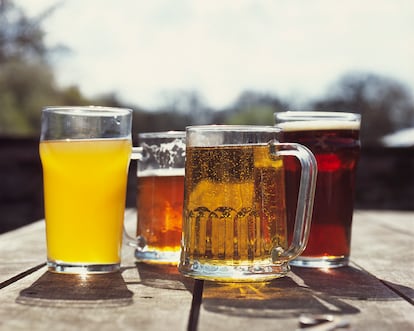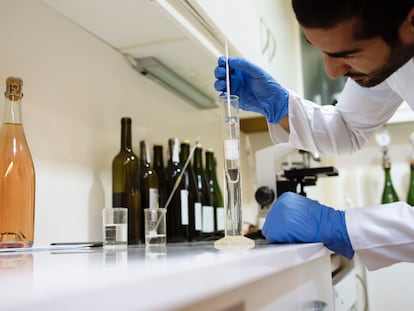Can you really be allergic to alcohol?
It is necessary to discover whether the allergic reactions are caused by congeners, histamines, yeasts, sulfites, additives or allergens of plant origin in beverages

Some people get allergy-like symptoms when drinking alcohol, but can you really be allergic to alcohol? Alcohol allergies are rare, with documented cases primarily involving a rash. However, what often perplexes people are the symptoms that mimic allergies, such as wheezing, headaches and skin flushing.
These reactions, more often than not, are attributed to alcohol exacerbating underlying conditions like asthma, urticaria (hives) and rhinitis. The reason is that alcohol dilates blood vessels, which then sets the stage for a symphony of bodily responses.
The term “alcohol intolerance” becomes key in deciphering these reactions. Unlike allergies, which involve the immune system, intolerances arise when the body lacks the necessary enzymes to digest and eliminate alcohol. The consequence? Unusual symptoms that may leave one questioning whether the drink in hand is a source of enjoyment or distress.
Not just the alcohol
As we peer into the bottom of our glasses, it becomes clear that the source of these reactions is not just the alcohol but the complex composition of the drink. Red wine often takes center stage as a provocateur of reactions, followed by whiskey, beer and other wines. The usual suspects, however, are not the alcohol molecules but the enigmatic chemicals known as congeners.
Congeners, responsible for the body, aroma and flavour of a drink, play a subtle yet significant role in the orchestration of reactions. But can these congeners induce true allergic reactions? To answer this, we delve into the substances within alcoholic beverages that might induce bodily responses.
Histamine, a familiar name to allergy sufferers, emerges as a prominent figure in this narrative. Present in abundance, particularly in red wines, histamine can be the instigator of headaches, flushing, nasal symptoms, gut disturbances or even asthma. Those intolerant to histamine may grapple with these symptoms because their body is unable to break down and eliminate this compound.
While yeast allergies are not unheard of, studies cast a reassuring light on the low levels of yeast allergens in alcoholic drinks. True allergic reactions stemming from yeasts are a rare occurrence, dampening the suspicion that this microscopic organism is the chief cause.
Sulphur dioxide, commonly found in home-brewed beers and wines, especially in the form of sodium metabisulphite, is another potential culprit. About one in ten asthmatics may find themselves wheezing in response to sulphites, with rashes and anaphylactic reactions being the exception rather than the rule.

Sulphites are one of 14 allergens that must be listed in bold in all prepared foods and restaurants.
In the realm of additives, substances like tartrazine and sodium benzoate emerge as potential instigators of urticaria and asthma. As we sift through the components that constitute our favorite drinks, the awareness of these additives becomes pivotal for those navigating sensitivities.
The very essence of alcoholic beverages lies in the plants from which they derive – be it grapes, apples, juniper berries, coconuts, oranges, hops or malt. While these plant-derived allergens can theoretically trigger true allergic reactions, most are destroyed during processing.
An exception, albeit a rare one, is the potential trouble posed by fungal spores (mold) from the corks of wine bottles. Sensitivity to this fungus is uncommon, but for those at risk, a visible mold-laden cork could expose them to an unwarranted dose of allergen.
Discover the culprit
For those grappling with these enigmatic reactions, avoidance is often the best course of action. Keeping meticulous records of the drink type, accompanying consumables, and physical activities during the episode can assist in identifying triggers. If all alcoholic drinks seem to induce reactions, it might signal an exaggerated response to alcohol or an exacerbation of an underlying condition.
As we raise our glasses to the complexity of alcohol-related reactions, a journey through the nuances of congeners, histamines, yeasts, sulphites, additives and plant-derived allergens unfolds. In the spirit of scientific exploration, the quest for a comprehensive understanding of these reactions continues, promising insights that may one day unveil the mysteries behind the intricate dance between our bodies and the libations we savor.
Samuel J. White is Senior Lecturer in Genetic Immunology, Nottingham Trent University.
Philippe B. Wilson is Professor of One Health, Nottingham Trent University.
Sign up for our weekly newsletter to get more English-language news coverage from EL PAÍS USA Edition
Tu suscripción se está usando en otro dispositivo
¿Quieres añadir otro usuario a tu suscripción?
Si continúas leyendo en este dispositivo, no se podrá leer en el otro.
FlechaTu suscripción se está usando en otro dispositivo y solo puedes acceder a EL PAÍS desde un dispositivo a la vez.
Si quieres compartir tu cuenta, cambia tu suscripción a la modalidad Premium, así podrás añadir otro usuario. Cada uno accederá con su propia cuenta de email, lo que os permitirá personalizar vuestra experiencia en EL PAÍS.
¿Tienes una suscripción de empresa? Accede aquí para contratar más cuentas.
En el caso de no saber quién está usando tu cuenta, te recomendamos cambiar tu contraseña aquí.
Si decides continuar compartiendo tu cuenta, este mensaje se mostrará en tu dispositivo y en el de la otra persona que está usando tu cuenta de forma indefinida, afectando a tu experiencia de lectura. Puedes consultar aquí los términos y condiciones de la suscripción digital.
More information
Archived In
Últimas noticias
From digital curfews to blocking apps: How technology experts protect their children online
Why the price of coffee has skyrocketed: from Brazilian plantations to specialty coffee houses
Confined to a Cuban hospital: When electricity is a matter of life or death
The complicated life of Francesca Albanese: A rising figure in Italy but barred from every bank by Trump’s sanctions
Most viewed
- Why we lost the habit of sleeping in two segments and how that changed our sense of time
- Trump’s obsession with putting his name on everything is unprecedented in the United States
- Pablo Escobar’s hippos: A serious environmental problem, 40 years on
- The Florida Keys tourist paradise is besieged by immigration agents: ‘We’ve never seen anything like this’
- Charles Dubouloz, mountaineering star, retires at 36 with a farewell tour inspired by Walter Bonatti










































